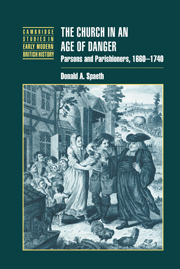Book contents
- Frontmatter
- Contents
- List of tables
- Acknowledgements
- List of abbreviations
- 1 Introduction
- 2 Clerical profiles
- 3 Arenas for conflict
- 4 The management of disputes
- 5 Pastoral care
- 6 Tithes and religious conflict
- 7 The nonconformist threat
- 8 Popular observance
- 9 Matters of life and death
- 10 Singing and religious revival
- 11 Conclusion
- Selected bibliography
- Index
- Cambridge Studies in Early Modern British History
11 - Conclusion
Published online by Cambridge University Press: 28 July 2009
- Frontmatter
- Contents
- List of tables
- Acknowledgements
- List of abbreviations
- 1 Introduction
- 2 Clerical profiles
- 3 Arenas for conflict
- 4 The management of disputes
- 5 Pastoral care
- 6 Tithes and religious conflict
- 7 The nonconformist threat
- 8 Popular observance
- 9 Matters of life and death
- 10 Singing and religious revival
- 11 Conclusion
- Selected bibliography
- Index
- Cambridge Studies in Early Modern British History
Summary
There was much that was positive about the Church of England in the late seventeenth and early eighteenth centuries. Anglican worship was able to command considerable popular support. It was not merely imposed upon unwilling congregations by a partnership of squire and parson. The laity accepted the Church's standing as the institutional focus of religious worship. They also accepted the clergy's professional and intellectual position, and valued their pastoral role. Parishioners insisted that the role which the liturgy defined for parsons as officiants at divine service and communion and at key rites of passage was vital to the spiritual welfare of the community. The radical sects had contributed to Interregnum concerns about disorder, and most people greeted the return of the Church at the Restoration with relief. Anglicanism was reinvigorated in the early eighteenth century, both at the grass roots and nationally. The Society for Promoting Christian Knowledge reached out to parishes through its extensive network of correspondents, and its successes were made possible by the support and enthusiasm of these local ministers, who were already committed to the cure of souls of their parishioners. These men showed imagination and energy in promoting religious education and singing, and their pastoral efforts bore fruit. In Salisbury diocese, Bishop Gilbert Burnet embarked on an ambitious programme of reform intended to raise clerical standards, improve pastoral care and reawaken the spirit of religion among the people.
- Type
- Chapter
- Information
- The Church in an Age of DangerParsons and Parishioners, 1660–1740, pp. 254 - 259Publisher: Cambridge University PressPrint publication year: 2000
- 1
- Cited by

